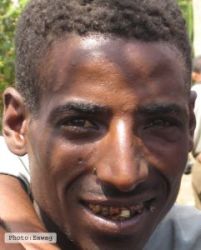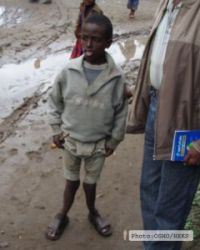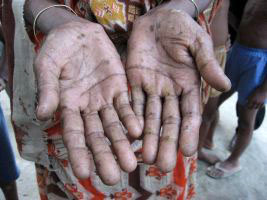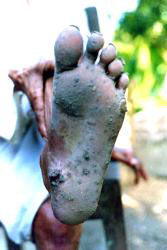Department Water Resources and Drinking Water
Mitigation of geogenic groundwater contamination
Water Resource Quality (WRQ) was an integrated project running from 2006-2012 at Eawag that aimed to develop a generally applicable framework for the mitigation of geogenic contamination in groundwater used for drinking, in particular concerning arsenic and fluoride. We combined natural and social scientific expertise for the solution of a health problem that affects 100s of millions of people worldwide. The mitigation framework developed by the WRQ team from Eawag can help decision makers and water resource managers to identify contaminated regions and to provide feasible options to help reduce the effects of contamination.
Geogenic Contamination
Geogenic contamination refers to naturally occurring elevated concentrations of certain elements in groundwater (such as arsenic, fluoride, uranium or selenium) which have a negative health effect on humans consuming this water. Geogenic contamination of groundwater might be a result of geochemical characteristics of the aquifer material - eg. high concentrations of the contaminant in the rock matrix, dissolving during water-rock interaction, or occur due to environmental conditions such as an arid climate or reducing conditions in the aquifer which facilitate the contaminant to occur in a more mobile state.
The most wide-spread geogenic contaminants are arsenic and fluoride, affecting the health of hundreds of millions of people worldwide.
Fluoride
Fluoride is the 13th most abundant element in the earth’s crust (625 mg/kg) and exists in trace amounts in almost all groundwaters across the world. According to estimations from UNESCO, more than 200 million people worldwide rely on drinking water with fluoride concentrations exceeding the present WHO guideline of 1.5 mg/L. Fluorosis, associated with elevated fluoride concentrations in drinking water has been reported in a range of countries.
While low fluoride intake may prevent dental caries, excess intake causes different types of fluorosis; primarily dental and skeletal fluorosis. White line striations on the teeth followed by brown patches and, in severe cases, brittling of the enamel are common symptoms of dental fluorosis. This is not only a health problem but also has psychological and social impacts, as people are ashamed and possibly ostracised due to their bad teeth. Skeletal fluorosis first causes pain in different joints, then limits joint movement, leading to stiffness and skeletal crippling. Besides dental and skeletal fluorosis, other manifestations such as nervousness, depression and muscle weakness have been reported in connection with high fluoride intake.
More information
Where does fluoride groundwater contamination occur?
What are the effects of fluoride on human health?




Arsenic
The WHO guideline value for arsenic in drinking water has been set to 10 µg/L, though in several countries higher values are used (e.g. 50 µg/L in China).
High arsenic concentrations in groundwater have been found to be responsible for health problems summarized under the term arsenicosis, which develop over a period of several years. Symptoms of arsenicosis range from skin disorders (melanosis, keratosis) to cardiovascular diseases, cancer and the impairment of the neurodevelopment of children. Since there is no cure for arsenicosis to date, the provision of safe water for the prevention of this disease is the vital mitigation approach.
More information
Where does arsenic groundwater contamination occur?


Team
WRQ was an inter-disciplinary project and the development of the framework relied on the integration of expertise from a range of fields. An understanding of the physical system, together with socio-economic and behavioural factors at different scales were necessary. Scientists from three Eawag departments were involved:
- Water Resources and Drinking Water (W+T)
- System Analysis, Integrated Assessment and Modelling (SIAM)
- Water and Sanitation in Developing Countries (SANDEC)
The project team therefore comprised geochemical specialists, modelers and social scientists and relied on the cooperation with valuable global partners. It was initiated and led by Dr. Annette Johnson, who passed away in November 2015. One of her special areas was the handling of geogenic trace substances in ground water and drinking water (click for further information on Annette Johnsons research).
WRQ team at Eawag
- GIS modelling and arsenic removal
- WRQ project management
- Arsenic removal
- Deep well evaluation
- GIS modelling and arsenic removal
- Development of online GIS modelling tools
- Material flow analysis
- Uptake of fluoride through food and water
- Institutional and socio-economic research
Former team members
Dr. Annette Johnson | WRQ project manager |
Dr. Chris Zurbrügg | WRQ project management |
Dr. Christoph Lüthi | Institutional settings and enabling environments |
Dr. Hansi Mosler | Psychological acceptance and promotion studies |
Anja Bretzler | WRQ managing assistant |
Dr. Luis Rodriguez-Lado | Post-doctoral researcher |
Dr. Hanspeter Bader | Material flow analysis |
Jennifer Inauen |
|
Alexandra Huber |
|
Lars Osterwalder |
|
Dr. Heiko Gebauer |
|
Dr. Richard Johnston |
|
Dr. Manouchehr Amini |
|
Dr. Lenny Winkel |
|
Dr. Robert Tobias |
|
Dr. Nasreen Khan |
|
Yama Tomonaga |
|
Kim Müller |
|
Thomas Rosenberg |
|
Partners
The WRQ team maintains partnerships with research institutions and NGOs in a range of countries where problems occur due to geogenic contamination of drinking water.
Ethiopia
Addis Ababa University, Ethiopia
In 2009 Eawag and Addis Ababa University (AAU) launched a three-year research project funded by the Swiss National Science Foundation and the Swiss Agency for Development and Cooperation (SNF-SDC) with the title “Optimization and Acceptance of Fluoride Removal Options in Rural Ethiopia”.
The WRQ fluoride removal team is working together with Dr. Feleke Zewge from AAU's Chemistry Department and Head of the Fluorosis Mitigation Office on the development and testing of different filter materials based on aluminium oxide or calcium phosphate for the removal of fluoride from drinking water.
The institutional support for the implementation of fluoride mitigation strategies is being investigated in cooperation with Prof. Yacob Arsano from the Department of Political Science and International Relations.
Non-Government Organisations (NGOs)
Field trials of bone char-based filters on a household as well as community scale are being undertaken in rural communities in the Rift Valley in cooperation with the Oromo Self-Help Organisation (OSHO) and Swiss Interchurch Aid (HEKS). OSHO offers vital assistance in the implementation, distribution and monitoring of filters and in the realisation of household surveys on filter use and acceptance. We are grateful to HEKS for their financial support
Bangladesh
Extensive work on arsenic mitigation in Bangladesh would not be possible without the cooperation with a range of local partners:
1) Dr. Kazi Matin Ahmed, professor in the University of Dhaka's Geology Department, is a global expert on arsenic contamination of groundwater. We work together in assessing the quality of groundwater in different geological units, not only in terms of arsenic but other chemical parameters including iron, manganese, and salinity. By identifying strata which yield favorable water for all chemical parameters, new water sources can be installed which truly provide safe drinking water.
2) UNICEF Bangladesh has been one of the leading agencies responding to the arsenic threat facing Bangladesh. Our team of environmental psychologists is fielding surveys with support from UNICEF to identify the driving psychological factors which cause people to adopt (or to not adopt) new arsenic-safe sources of drinking water. Results will inform an ongoing revision of UNICEF's arsenic communication strategy. Our team members also coordinate with UNICEF Bangladesh on interpretation of nation-wide drinking water quality surveys.
3) SONO Technology Research (STR), LTD, Kushtia, Bangladesh and Prof. Abul Hussam of George Mason University (GMU) in Fairfax, Virginia, USA, have developed the award-winning SONO arsenic removal filter. In collaboration with STI and Prof. Abul Hussam, Eawag scientists have carried out research to test the long-term performance of the filters and help to better understand the physical and chemical processes in the different filter sections.
4) Dhaka Community Hospital
Kenya
Catholic Diocese of Nakuru
In spring 2006, Eawag and the Catholic Diocese of Nakuru (CDN) launched a joint collaboration with the main objectives:
- to further develop and optimize a low-cost defluoridation method known as contact precipitation
- to investigate the removal processes for bone char defluoridation and contact precipitation
- to foster implementation and dissemination of apatite-based defluoridation treatment
The Water Programme of the Catholic Diocese of Nakuru (CDN) was created in 1985. Today the Programme employs approximately 60 people and operates in several areas within Eastern Africa. Major activities are: drilling of deep wells, construction of water schemes and rainwater harvesting.
While working on the different water projects it became apparent that high levels of fluoride in the raw water lead to negative health impacts, commonly known as fluorosis. In 1998, a new section called CDN Water Quality (CDN WQ) was initiated as part of the Water Programme that took over the challenge to find a way to reduce fluoride levels in the water for safe human consumption.
CDN WQ comprises four working groups dealing with the production of bone char and calcium phosphate pellets, filter implementation, water quality testing and awareness creation. Up to date, more than 50 community and 1,000 household filters for fluoride removal have been implemented by CDN WQ in different parts of Kenya.
For further information, please contact info@cluttercdnwaterquality.co.ke
China
Since September 2009, researchers from the Research Center for Eco-Environmental Sciences in Beijing and from the China Medical University in Shenyang are our partners in the REMARC project (Risk Maps of Arsenic Contamination in Groundwaters of China). Their valuable contribution to the project made it possible to dispose of a database of 2,369 sampling points covering the provinces of Inner Mongolia, Gansu, Shanxi, Heilongjiang and Ningxia that will be used to build the risk models.
Mr. Guifan Sun
(Prof., MD)
Arsenic and Fluoride Research Centre, School of Public Health, China Medical University.
No. 92 Bei Er Road, Heping District, Shenyang, PR China, Postal Code: 110001
Telephone: +86-24-2326-1744
Fax: +86-24-2326-1744
E-mail: sungf@cluttermail.cmu.edu.cn
Prof Dr. Jianbo Shi
(Researcher, PhD)
State Key Laboratory of Environmental Chemistry and Ecotoxicology
Research Center for Eco-Environmental Sciences.
Chinese Academy of Sciences, P.O. Box 2871, Beijing 100085, China.
Telephone: +86-10-6284 9334
E-mail: jbshi@clutterrcees.ac.cn
Ms. Quanmei Zheng,
(Prof., MD)
Department of Geochemical Diseases, School of Public Health, China Medical University.
No. 92 Bei Er Road, Heping District, ShenyanChina Medical University.
No. 92 Bei Er Road, Heping District, Shenyang, PR China, Postal Code: 110001
Telephone: +86-24-2326-1744
Fax: +86-24-2326-1744
E-mail: qmzheng@cluttermail.cmu.edu.cn
Ms. Shuhua Xi
(Prof. PhD.)
Department of Geochemical Diseases, School of Public Health, China Medical University.
No. 92 Bei Er Road, Heping District, Shenyang China Medical University.
No. 92 Bei Er Road, Heping District, Shenyang, PR China, Postal Code: 110001
Telephone: +86-24-2326-1744
Fax: +86-24-2326-1744
E-mail: shxi@cluttermail.cmu.edu.cn
Qiang Zhang
(PhD student)
Arsenic and Fluoride Research Centre, School of Public Health, China Medical University.
No. 92 Bei Er Road, Heping District, Shenyang, PR China, Postal Code: 110001
Telephone: +86-24-2326-1744
Fax: +86-24-2326-1744
E-mail: z2008@cluttergmail.com
Iran
Isfahan University of Technology (IUT)
Eawag has long standing working relations with the College of Agriculture of Isfahan University of Technology (IUT) in Iran. In the past we have collaborated in many projects, including:
- Cation exchange capacity of arid soils [1]
- Mapping risk of cadmium and lead [2]
- Modelling cadmium variability [3]
- Modelling runoff and erosion using SWAT [4]
- Estimation of field capacity and wilting point for arid soils of central Iran from basic soil physical and chemical properties [5]
- Spatial and temporal variations of nitrate concentration in the groundwaters of Isfahan province, central Iran
- Temporal and spatial variability of soil moisture in Iran
- Assessment of regional water endowments, water constraints to food production, and implications for virtual water trade in Iran
- Hydrologic and water quality modeling of Zayandehrud Watershed
- Transport of cadmium, zinc, copper, and lead in a sewage sludge amended calcareous soil
- Estimating soil shear strength, saturated hydraulic conductivity and infiltration using pedotransfer function and artificial neural network
[1] Amini, M., K. C. Abbaspour, H. Khademi, N. Fathianpour, M. Afyuni, and R. Schulin. 2005. Neural Network Models to predict Cation Exchange Capacity in Arid Regions of Iran. European Journal of Soil Science. 56 (4): 551-559.
[2] Amini, M. Afyuni, H. Khademi, K. C. Abbaspour, R. Schulin. 2005. Mapping risk of cadmium and lead contamination to human health in soils of Central Iran. Science of Total Environment 347:54-77.
[3] Amini, M., M. Afyuni, H. Khademi, K. C. Abbaspour. 2005. Variability of Available Cadmium in Relation to Soil Properties and Landuse in Arid region of Central Iran. Water Air and Soil Pollution, 162:205-218.
[4] Rostamian, R., S. F. Mousavi, M. Heidarpour, M. Afyuni and K. C. Abbaspour. 2007. Application of SWAT Model for Estimating Runoff and Sediment in a Mountainous Watershed in Central Iran. The fourth International SWAT conference, Delft, Netherland.
[5] Nourbakhsh, F. M. Afyuni, K.C. Abbaspour, and R. Schulin. 2005. Estimation of field capacity and wilting point from basic soil physical and chemical properties. Arid Land Research and Management. 19:81-85.
Our research partners at IUT have agreed to collaborate with the WRQ project for a more detail and comprehensive study of F in Iran. The IUT collaborators include:
| Prof. Majid Afyuni | Environmental Soil Physics |
| Prof. Seyed Farhad Mousavi | Groundwater Resources |
| Prof. Hossein Khademi | Soil Minerology and Genesis |
| Dr. Ahmad Khatoonabadi | Social Science |
| Dr. Amir Khoshgoftar | Soil Chemist |
Vietnam
Hanoi University of Science: Centre of Environmental Technology and Sustainable Development
A long-term education and research partnership has been established between the Swiss Federal Institute of Aquatic Science and Technology (Eawag) and the Hanoi University of Science. Capacity building is accomplished by applied research projects in environmental chemistry and environmental engineering, as well as in pilot-scale and scaling-up studies for enhancing drinking water quality. Senior Vietnamese researchers and graduated students are educated in project planning and performing research including a strong emphasis on analytical quality control and elaborate data interpretation.
Arsenic contamination of groundwater and drinking water in Vietnam was discovered in 1998 within this capacity building program [1]. This finding has led to manifold studies, such as
- research on arsenic removal options [2]
- investigating the levels and state of human arsenic exposure [3]
- development of a low-cost biosensor for arsenic analysis [4]
- elucidation of geochemical mechanism(s) leading to arsenic contamination of groundwater [5]
- blanket groundwater surveys of the Red River Delta (Northern Vietnam) and the Mekong Delta (Cambodia and Southern Vietnam) [3, 6]
[1] “Arsenic Contamination of Groundwater and Drinking Water in Vietnam: A Human Health Threat.” Berg M. et al. 2001, Environ. Sci. Technol. 35, 2621–2626.
[2] “Arsenic Removal from Groundwater by Household Sand Filters: Comparative Field Study, Model Calculations, and Health Benefits.” Berg M. et al. 2006, Environ. Sci. Technol. 40, 5567–73.
[3] “Magnitude of arsenic pollution in the Mekong and Red River Deltas – Cambodia and Vietnam.” Berg M. et al. 2007, Sci. Total Environ. 372, 413–425.
[4] “Bacterial Bioassay for Rapid and Accurate Analysis of Arsenic in Highly Variable Groundwater Samples.” Trang et al. 2005, Environ. Sci. Technol. 39, 7625–30.
[5] “Hydrological and Sedimentary Controls Leading to Arsenic Contamination of Groundwater in the Hanoi Area, Vietnam.” Berg M. et al. submitted.
[6] “Arsenic and Manganese Contamination of Drinking Water Resources in Cambodia: Coincidence of Risk Areas with Low Relief Topography.” Buschmann et al 2007, Environ. Sci. Technol. 41, 2146–2152.
Publications
Water Quality
Water Resources / Water Availability
Food and Water Uptake
Dittmar, J., Voegelin, A., Roberts, L. C., Hug, S. J. Saha, G. C., Ali, M. A., Badruzzaman, A. B. M., Kretzschmar, R. (2007) Spatial Distribution and Temporal Variability of Arsenic in Irrigated Rice Fields in Bangladesh. 2. Paddy Soil. Environmental Science & Technology 41(17), 5967-5972
Technologies
- CDN's experiences in producing bone char
- CDN's defluoridation experiences on a household scale
- CDN's defluoridation experiences on a community scale
- CDN's experiences in integrating social aspects in fluorosis mitigation
- State-of-the-art of defluoridation techniques in East Africa (Sandec News 7, 2006, 12-13)
- Improving fluoride removal efficiency (Sandec News 9, 2008, 6)




